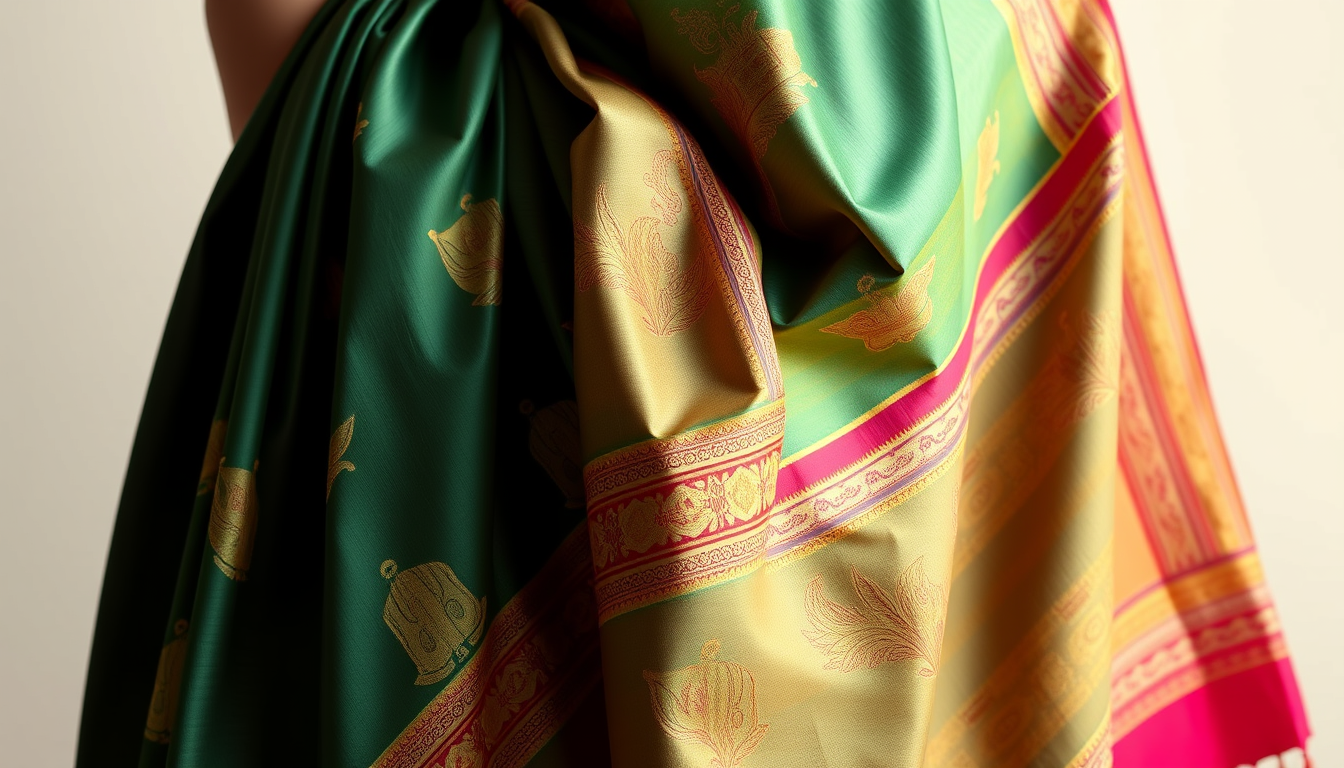Introduction
In the vibrant tapestry of Indian textiles, the Gadwal saree stands out as a symbol of elegance, craftsmanship, and cultural heritage. Originating from the small town of Gadwal in Telangana, these sarees are renowned for their intricate designs, vibrant colors, and rich history. This article delves into the captivating world of Indian Gadwal sarees, exploring their history, unique features, and significance in Indian fashion and culture.
The History of Gadwal Sarees
Origins and Evolution
The Gadwal saree has a rich history that dates back to the 16th century. The town of Gadwal, located in the Telangana region of India, is known for its silk weaving tradition. The sarees were initially woven for the royal families and the nobility, reflecting their opulence and grandeur. Over time, the sarees evolved to cater to the tastes of the common people, incorporating more vibrant colors and intricate patterns.
Traditional Techniques
The traditional technique of weaving Gadwal sarees involves the use of the pit loom, a method that has been passed down through generations. The sarees are typically made from silk, with a blend of cotton or other natural fibers. The intricate designs are created using various techniques such as ikat, block printing, and embroidery.
Unique Features of Gadwal Sarees
Design and Pattern
One of the most striking features of Gadwal sarees is their unique design and pattern. The sarees are known for their vibrant colors and intricate motifs. Common designs include floral patterns, geometric shapes, and traditional Telugu motifs. The borders of the sarees are often adorned with intricate zari work, adding an extra layer of elegance.
Fabric and Weaving
The fabric used in Gadwal sarees is typically silk, which gives the sarees a luxurious feel. The weaving technique is intricate, with the sarees often featuring a combination of plain and brocade fabrics. The use of natural dyes ensures that the colors are vibrant and long-lasting.
Embroidery and Zari Work
Embroidery and zari work are integral parts of the Gadwal saree. The sarees often feature intricate embroidery on the pallu (the border of the saree), which adds to their beauty and elegance. Zari work, which involves the use of gold or silver threads, is another prominent feature, adding a touch of glamour to the sarees.
Significance of Gadwal Sarees in Indian Culture
Traditional Festivals and Occasions
Gadwal sarees hold a significant place in Indian culture, particularly in the state of Telangana. They are often worn during traditional festivals and occasions such as weddings, festivals, and religious ceremonies. The sarees are a symbol of tradition, elegance, and cultural heritage.
Cultural Preservation
The weaving of Gadwal sarees is not just a craft but a way of life for many families in the region. The traditional techniques and designs are passed down from generation to generation, ensuring the preservation of cultural heritage. The sarees are a testament to the rich cultural diversity of India.
Modern Interpretations of Gadwal Sarees
Contemporary Designs
In recent years, there has been a renewed interest in traditional Indian textiles, including Gadwal sarees. Designers have been experimenting with modern interpretations of these sarees, incorporating contemporary designs and colors. This has led to the creation of Gadwal sarees that are both traditional and modern, appealing to a wider audience.
Sustainability and Ethical Practices
There is also a growing focus on sustainability and ethical practices in the production of Gadwal sarees. Many artisans are adopting eco-friendly practices, using natural dyes and sustainable fabrics. This not only preserves the environment but also ensures the longevity of the sarees.
How to Care for Your Gadwal Saree
Storage
Proper storage is crucial to maintain the quality of your Gadwal saree. Store the saree in a cool, dry place, away from direct sunlight and heat. Avoid folding the saree, as this can cause creases. Instead, roll it up gently and store it in a cotton bag or a saree hanger.
Washing
Gadwal sarees should be washed gently to prevent damage to the fabric and the intricate designs. Use a mild detergent and cold water. Avoid using harsh chemicals or bleach. After washing, dry the saree naturally, away from direct sunlight.
Ironing
Ironing a Gadwal saree requires caution. Use a low heat setting and iron the saree while it is still slightly damp. This helps to remove any wrinkles without damaging the fabric.
Conclusion
The Indian Gadwal saree is a testament to the rich cultural heritage and traditional craftsmanship of India. With its unique design, vibrant colors, and intricate patterns, the saree continues to captivate fashion enthusiasts and cultural connoisseurs alike. As the saree evolves with modern interpretations and sustainable practices, it remains a symbol of elegance, tradition, and cultural pride. Whether you are a fashion enthusiast or a cultural explorer, the Gadwal saree is a must-have addition to your wardrobe.
Frequently Asked Questions
What is the origin of Gadwal sarees?
Gadwal sarees originate from the town of Gadwal in Telangana, India. They have a history dating back to the 16th century.
What are the unique features of Gadwal sarees?
The unique features of Gadwal sarees include their vibrant colors, intricate designs, silk fabric, and traditional weaving techniques.
How do you care for a Gadwal saree?
To care for a Gadwal saree, store it in a cool, dry place, wash it gently with mild detergent, dry it naturally, and iron it with low heat while slightly damp.
What is the significance of Gadwal sarees in Indian culture?
Gadwal sarees hold significant cultural importance in India, particularly in the state of Telangana. They are worn during traditional festivals and occasions and are a symbol of cultural heritage and tradition.
How have Gadwal sarees evolved in modern times?
In modern times, Gadwal sarees have been reinterpreted with contemporary designs and colors, while also adopting sustainable and ethical practices in their production.
Keywords
Indian Gadwal saree, Telangana, silk weaving, traditional techniques, vibrant colors, intricate designs, cultural heritage, modern interpretations, sustainability, ethical practices, care for sarees.
